Genome-Wide Identification of the WRKY Gene Family and Functional Characterization of CpWRKY5 in Cucurbita pepo
Abstract
1. Introduction
2. Results
2.1. Identification and Evaluation of Chromosomal Location, Multiple Sequence Alignment, and Phylogenetic Relationships of CpWRKY Proteins
2.2. Gene Structure and Conserved Motif Analysis of CpWRKYs
2.3. Synteny and Collinearity Analyses
2.4. Analysis of Cis-Acting Elements in the Promoters of CpWRKYs
2.5. Expression Analysis of WRKY TFs of Seed Coat Development in C. pepo
2.6. CpWRKY5 Positively Regulates Lignin Synthesis in Transgenic Tobacco
3. Discussion
4. Materials and Methods
4.1. Plant Materials
4.2. Identification and Characterization of Putative WRKY Genes in C. pepo
4.3. Sequence Alignment, Phylogenetic Tree, Classification, Gene Structure, and Conserved Motif Analyse
4.4. Chromosomal Location, Gene Duplication, Collinearity Analyses, and Cis-Acting Elements in the Promoters of the CpWRKY Family Genes
4.5. Gene Expression Analysis
4.6. Construction of Transgenic Nicotiana tabacum Overexpressing CpWRKY5
4.7. Determination of Lignin Content and Related Gene Expression
5. Conclusions
Supplementary Materials
Author Contributions
Funding
Institutional Review Board Statement
Informed Consent Statement
Data Availability Statement
Acknowledgments
Conflicts of Interest
References
- Decker, D.S. Origin(s), evolution, and systematic of Cucurbita pepo (Cucurbitaceae). Econ. Bot. 1988, 42, 4–15. [Google Scholar] [CrossRef]
- Cvetkovic, D.; Stanojevic, L.; Zvezdanovic, J.; Stanojevic, J.; Savic, D.; Karabegovic, I.; Danilovic, B. Pumpkin fruit (Cucurbita pepo L.) as a source of phytochemicals useful in food and pharmaceutical industries. J. Food Meas. Charact. 2021, 15, 4596–4607. [Google Scholar] [CrossRef]
- Teppner, H. Cucurbita pepo (Cucurbitaceae)—History, seed coat types, thin coated seeds and their genetics. Phyton 2000, 40, 1–42. [Google Scholar]
- Bezold, T.N.; Mathews, D.; Loy, J.B.; Minocha, S.C. Molecular analysis of the hull-less seed trait in pumpkin: Expression profles of genes related to seed coat development11. Seed Sci. Res. 2005, 3, 205–217. [Google Scholar] [CrossRef]
- Makni, M.; Fetoui, H.; Gargouri, N.K.; Garouri, E.M.; Zeghal, N. Antidiabetic effect of flax and pumpkin seed mixture powder: Effect on hyperlipidemia and antioxidant status in alloxan diabetic rats. J. Diabetes Complicat. 2011, 25, 339–345. [Google Scholar] [CrossRef]
- Bahadori, M.H.; Azari, Z.; Zaminy, A.; Dabirian, S.; Mehrdad, S.M.; Kondori, B.J. Anti-proliferative and apoptotic effects of hull-less pumpkin extract on human papillary thyroid carcinoma cell line. Anat. Cell Biol. 2021, 54, 104–114. [Google Scholar] [CrossRef]
- Lelley, T.; Loy, B.L.; Murkovic, M. Hull-Less oil seed pumpkin. In Oil Crops, Handbook of Plant Breeding; Vollmann, J., Rajcan, I., Eds.; Springer: New York, NY, USA, 2009; pp. 469–492. [Google Scholar]
- Meru, G.; Fu, Y.Q.; Shrestha, S.; Michael, V.N.; Dorval, M.; Mainviel, R. Genomic Position and Markers Associated with the Hull-Less Seed Trait in Pumpkin. Plants 2022, 11, 1238. [Google Scholar] [CrossRef]
- Loy, J. Seed development in Cucurbita pepo: An overview with emphasis on hull-less seeded genotypes of pumpkin. Rep.-Cucurbit Genet. Coop. 2000, 23, 89–95. [Google Scholar]
- Zhou, X. A study on the breeding of naked kernel pumpkin and its genetic behavior. Acta Hortic. Sin. 1987, 2, 115–118. [Google Scholar]
- Zhang, Z. Studies on the heredity of some characters in seed shell-less of squash. Acta Agric. Boreali-Occident. Sin. 2004, 3, 93–96. [Google Scholar]
- Li, Z.; Qu, S.; Cui, C. Development of AFLP and SCAR markers linked to hull-less n gene in pumpkin (Cucurbita pepo L.). J. Northeast Agric. Univ. 2011, 42, 67–71. [Google Scholar]
- Murovec, J.; Draslar, K.; Bohanec, B. Detailed analysis of Cucurbita pepo seed coat types and structures with scanning electron microscopy. Botany 2012, 90, 1161–1169. [Google Scholar] [CrossRef]
- Chahal, G.K. A Single-Gene Mutation Changed the Architecture of Pumpkin Seed: A Review. J. Plant Growth Regul. 2022, 41, 113–118. [Google Scholar] [CrossRef]
- Zhao, Q.; Dixon, R.A. Transcriptional networks for lignin biosynthesis: More complex than we thought? Trends Plant Sci. 2011, 16, 227–233. [Google Scholar] [CrossRef]
- Chi, Y.; Yang, Y.; Zhou, Y.; Zhou, J.; Fan, B.; Yu, J.Q.; Chen, Z. Protein-protein interactions in the regulation of WRKY transcription factors. Mol. Plant 2013, 6, 287–300. [Google Scholar] [CrossRef]
- Chen, C.; Chen, X.; Han, J.; Lu, W.; Ren, Z. Genome-wide analysis of the WRKY gene family in the cucumber genome and transcriptome-wide identification of WRKY transcription factors that respond to biotic and abiotic stresses. BMC Plant Biol. 2020, 20, 443. [Google Scholar] [CrossRef]
- Eulgem, T.; Rushton, P.J.; Robatzek, S.; Somssich, I.E. The WRKY superfamily of plant transcription factors. Trends Plant Sci. 2000, 5, 199–206. [Google Scholar] [CrossRef]
- Zhang, Z.; Quan, S.; Niu, J.; Guo, C.; Kang, C.; Liu, J.; Yuan, X. Genome-Wide Identification, Classification, Expression and Duplication Analysis of bZIP Family Genes in Juglans regia L. Int. J. Mol. Sci. 2022, 23, 5961. [Google Scholar] [CrossRef]
- Yang, X.; Li, H.; Yang, Y.; Wang, Y.; Mo, Y.; Zhang, R.; Zhang, Y.; Ma, J.; Wei, C.; Zhang, X. Identification and expression analyses of WRKY genes reveal their involvement in growth and abiotic stress response in watermelon (Citrullus lanatus). PLoS ONE 2018, 13, e0191308. [Google Scholar] [CrossRef]
- Cheng, Y.; Luo, J.; Li, H.; Wei, F.; Zhang, Y.; Jiang, H.; Peng, X. Identification of the WRKY Gene Family and Characterization of Stress-Responsive Genes in Taraxacum kok-saghyz Rodin. Int. J. Mol. Sci. 2022, 23, 10270. [Google Scholar] [CrossRef]
- Wani, S.H.; Anand, S.; Singh, B.; Bohra, A.; Joshi, R. WRKY transcription factors and plant defense responses: Latest discoveries and future prospects. Plant Cell Rep. 2021, 40, 1071–1085. [Google Scholar] [CrossRef]
- Yamasaki, K.; Kigawa, T.; Inoue, M.; Tateno, M.; Yamasaki, T.; Yabuki, T.; Aoki, M.; Seki, E.; Matsuda, T.; Tomo, Y.; et al. Solution structure of an Arabidopsis WRKY DNA binding domain. Plant Cell 2005, 17, 944–956. [Google Scholar] [CrossRef]
- Rushton, P.J.; Somssich, I.E.; Ringler, P.; Shen, Q.J. WRKY transcription factors. Trends Plant Sci. 2010, 15, 247–258. [Google Scholar] [CrossRef]
- Yuan, H.; Guo, W.; Zhao, L.; Yu, Y.; Chen, S.; Tao, L.; Cheng, L.; Kang, Q.; Song, X.; Wu, J.; et al. Genome-wide identification and expression analysis of the WRKY transcription factor family in flax (Linum usitatissimum L.). BMC Genom. 2021, 22, 375. [Google Scholar] [CrossRef]
- Johnson, C.S.; Kolevski, B.; Smyth, D.R. TRANSPARENT TESTA GLABRA2, a trichome and seed coat development gene of Arabidopsis, encodes a WRKY transcription factor. Plant Cell 2022, 14, 1359–1375. [Google Scholar] [CrossRef]
- Gallego-Giraldo, L.; Shadle, G.; Shen, H.; Barros-Rios, J.; Fresquet, C.S.; Wang, H.; Dixon, R.A. Combining enhanced biomass density with reduced lignin level for improved forage quality. Plant Biotechnol. J. 2016, 14, 895–904. [Google Scholar] [CrossRef]
- Xue, Y.; Shen, Z.; Tao, F.; Zhou, J.; Xu, B. Transcriptomic Analysis Reveal the Molecular Mechanisms of Seed Coat Development in Cucurbita pepo L. Front. Plant Sci. 2022, 13, 772685. [Google Scholar] [CrossRef]
- Yang, Y.; Zhou, Y.; Chi, Y.; Fan, B.; Chen, Z. Characterization of Soybean WRKY Gene Family and Identification of Soybean WRKY Genes that Promote Resistance to Soybean Cyst Nematode. Sci. Rep. 2017, 7, 17804. [Google Scholar] [CrossRef]
- Hu, W.; Ren, Q.; Chen, Y.; Xu, G.; Qian, Y. Genome-wide identification and analysis of WRKY gene family in maize provide insights into regulatory network in response to abiotic stresses. BMC Plant Biol. 2021, 21, 427. [Google Scholar] [CrossRef] [PubMed]
- Fan, X.; Guo, Q.; Xu, P.; Gong, Y.; Shu, H.; Yang, Y.; Ni, W.; Zhang, X.; Shen, X. Transcriptome-wide identification of salt-responsive members of the WRKY gene family in Gossypium aridum. PLoS ONE 2015, 10, e0126148. [Google Scholar] [CrossRef] [PubMed]
- Zhang, G.Y.; Wei, B.Q. Identification of WRKY gene family and their expression analysis under low-temperature stress in melon (Cucumis melo). Chin. J. Agric. Biotechol. 2020, 28, 1761–1775. [Google Scholar]
- Ferriol, M.; Picó, B.; Nuez, F. Genetic diversity of a germplasm collection of Cucurbita pepo using SRAP and AFLP markers. TAG. Theoretical and applied genetics. Theor. Appl. Genet. 2003, 107, 271–282. [Google Scholar] [CrossRef] [PubMed]
- Rinerson, C.I.; Rabara, R.C.; Tripathi, P.; Shen, Q.J.; Rushton, P.J. The evolution of WRKY transcription factors. BMC Plant Biol. 2015, 15, 66. [Google Scholar] [CrossRef]
- Hu, L.; Wang, P.; Hao, Z.; Lu, Y.; Xue, G.; Cao, Z.; Qu, H.; Cheng, T.; Shi, J.; Chen, J. Gibberellin Oxidase Gene Family in L. chinense: Genome-Wide Identification and Gene Expression Analysis. Int. J. Mol. Sci. 2021, 22, 7167. [Google Scholar] [CrossRef]
- Brand, L.H.; Fischer, N.M.; Harter, K.; Kohlbacher, O.; Wanke, D. Elucidating the evolutionary conserved DNA-binding specificities of WRKY transcription factors by molecular dynamics and in vitro binding assays. Nucleic Acids Res. 2013, 41, 9764–9778. [Google Scholar] [CrossRef]
- Cao, P.; Liu, X.; Guo, J.; Chen, Y.; Li, S.; Wang, C.; Min, Y. Genome-Wide Analysis of Dynamin Gene Family in cassava (Manihot esculenta Crantz) and Transcriptional Regulation of Family Members ARC5 in Hormonal Treatments. Int. J. Mol. Sci. 2019, 20, 5094. [Google Scholar] [CrossRef]
- Diao, W.P.; Snyder, J.C.; Wang, S.B.; Liu, J.B.; Pan, B.G.; Guo, G.J.; Wei, G. Genome-Wide Identification and Expression Analysis of WRKY Gene Family in Capsicum annuum L. Front. Plant Sci. 2016, 7, 211. [Google Scholar] [CrossRef]
- Zhao, X.; Yang, J.; Qu, F.; Ma, G.; Tian, Y.; Wen, L. Cloning and expression analysis of key genes for lignin synthesis in Cucurbita pepo L. Braz. J. Bot. 2022, 45, 909–916. [Google Scholar]
- Wang, H.; Avci, U.; Nakashima, J.; Hahn, M.G.; Chen, F.; Dixon, R.A. Mutation of WRKY transcription factors initiates pith secondary wall formation and increases stem biomass in dicotyledonous plants. Proc. Natl. Acad. Sci. USA 2010, 107, 22338–22343. [Google Scholar] [CrossRef]
- Xue, H.; Cao, S.; Li, H.; Zhang, J.; Niu, J.; Chen, L.; Zhang, F.; Zhao, D. De novo transcriptome assembly and quantification reveal differentially expressed genes between soft-seed and hard-seed pomegranate (Punica granatum L.). PLoS ONE 2017, 12, e0178809. [Google Scholar] [CrossRef]
- Zhang, L.; Wu, D.; Zhang, W.; Shu, H.; Sun, P.; Huang, C.; Deng, Q.; Wang, Z.; Cheng, S. Genome-Wide Identification of WRKY Gene Family and Functional Characterization of CcWRKY25 in Capsicum chinense. Int. J. Mol. Sci. 2023, 24, 11389. [Google Scholar] [CrossRef] [PubMed]
- Zhu, L.; Guan, Y.; Zhang, Z.; Song, A.; Chen, S.; Jiang, J.; Chen, F. CmMYB8 encodes an R2R3 MYB transcription factor which represses lignin and flavonoid synthesis in chrysanthemum. Plant Physiol. Biochem. 2020, 149, 217–224. [Google Scholar] [CrossRef]
- Wen, F.; Wu, X.; Zhang, L.; Xiao, J.; Li, T.; Jia, M. Molecular Cloning and Characterization of WRKY12, A Pathogen Induced WRKY Transcription Factor from Akebia trifoliata. Genes 2023, 14, 1015. [Google Scholar] [CrossRef]
- Wang, S.S.; Chen, K.; Zhang, J.Y.; Wang, J.Q.; Li, H.S.; Yang, X.Y.; Shi, Q.H. Genome-wide characterization of MATE family members in Cucumis melo L. and their expression profiles in response to abiotic and biotic stress. Hortic. Plant J. 2022, 8, 474–488. [Google Scholar] [CrossRef]
- Montero-Pau, J.; Blanca, J.; Bombarely, A.; Ziarsolo, P.; Esteras, C.; Martí-Gómez, C.; Ferriol, M.; Gómez, P.; Jamilena, M.; Mueller, L.; et al. De novo assembly of the zucchini genome reveals a whole-genome duplication associated with the origin of the Cucurbita genus. Plant Biotechnol. J. 2018, 16, 1161–1171. [Google Scholar] [CrossRef]
- Xu, Z.; Liu, Y.; Fang, H.; Wen, Y.; Wang, Y.; Zhang, J.; Peng, C.; Long, J. Genome-Wide Identification and Expression Analysis of WRKY Gene Family in Neolamarckia cadamba. Int. J. Mol. Sci. 2023, 24, 7537. [Google Scholar] [CrossRef]
- Obrero, A.; Die, J.V.; Román, B.; Gómez, P.; Nadal, S.; González-Verdejo, C.I. Selection of reference genes for gene expression studies in zucchini (Cucurbita pepo) using qPCR. J. Agric. Food Chem. 2011, 59, 5402–5411. [Google Scholar] [CrossRef]
- Livak, K.J.; Schmittgen, T.D. Analysis of relative gene expression data using real-time quantitative PCR and the 2 (-Delta Delta C (T)) Method. Methods 2001, 25, 402–408. [Google Scholar] [CrossRef]
- Wang, R.; Li, Z.F.; Lu, P.; Meng, L.J.; Cao, P.J. Identification and validation of tobacco reference genes for qRT-PCR based on microarray data. Tobacco Sci. Technol. 2015, 48, 1–6. [Google Scholar]
- Song, Z.; Wang, D.; Gao, Y.; Li, C.; Jiang, H.; Zhu, X.; Zhang, H. Changes of lignin biosynthesis in tobacco leaves during maturation. Funct. Plant Biol. 2021, 48, 624–633. [Google Scholar] [CrossRef]
- Bruce, R.J.; West, C.A. Elicitation of lignin biosynthesis and isoperoxidase activity by pectic fragments in suspension cultures of castor bean. Plant Physiol. 1989, 91, 889–897. [Google Scholar] [CrossRef]
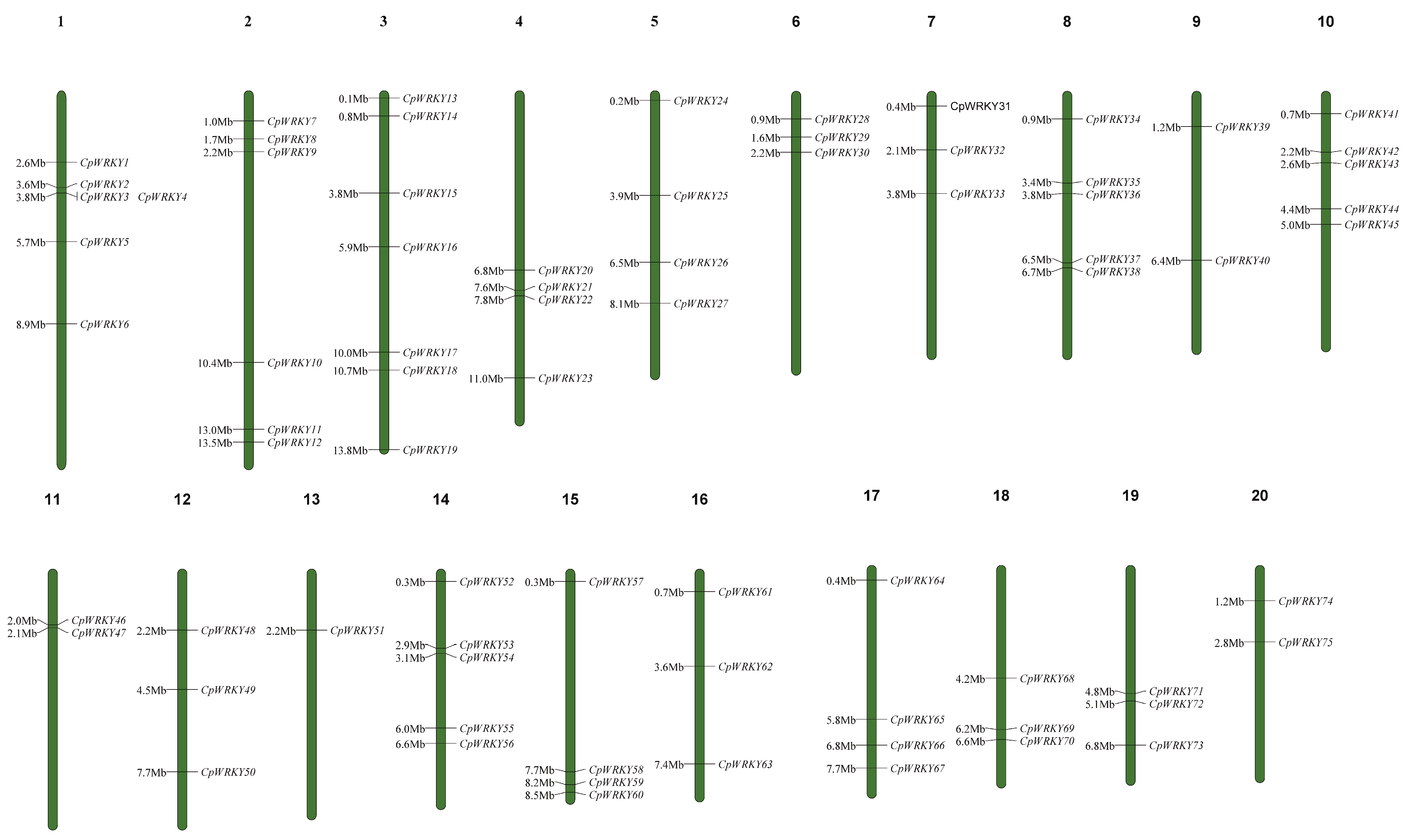
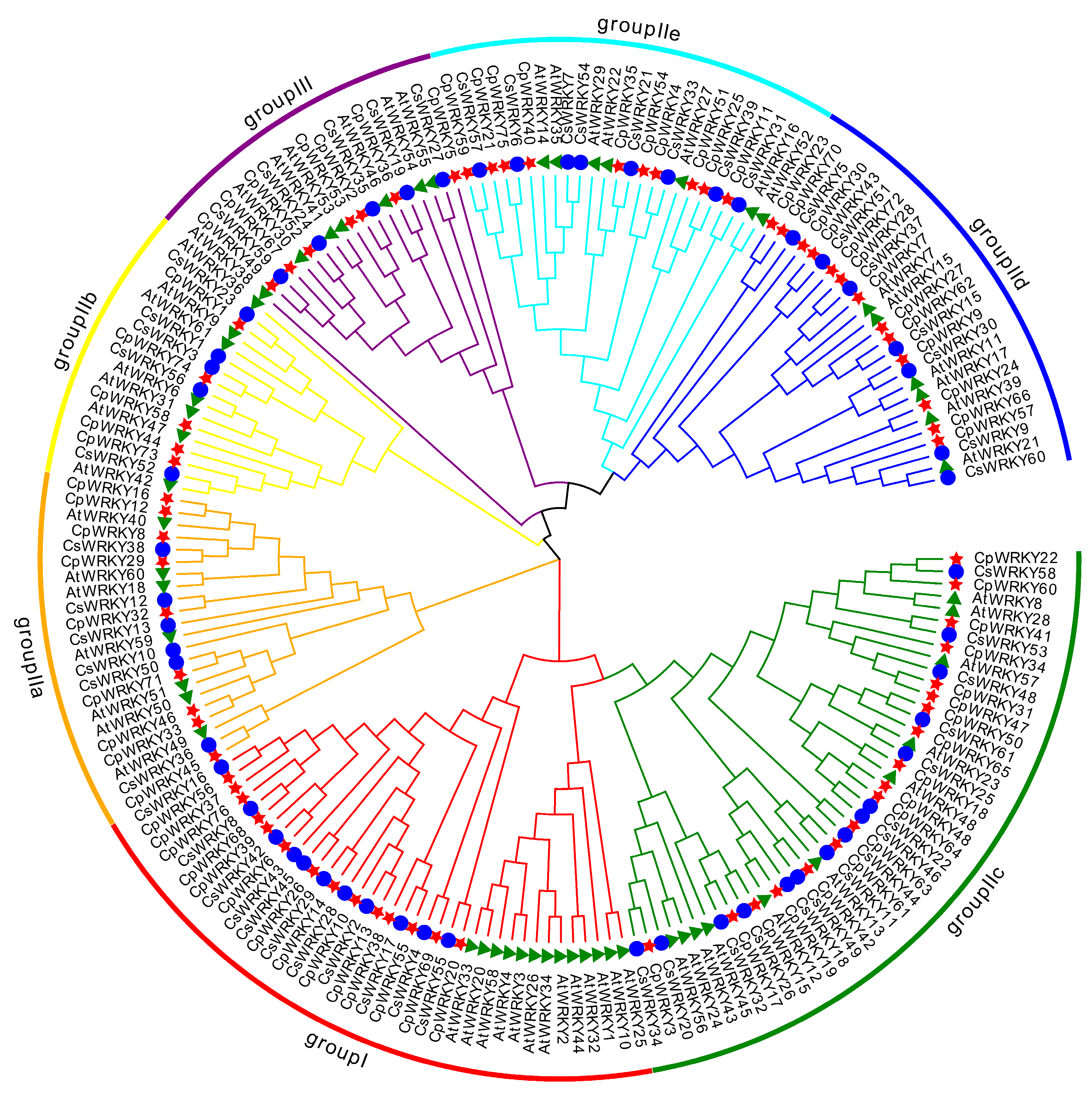
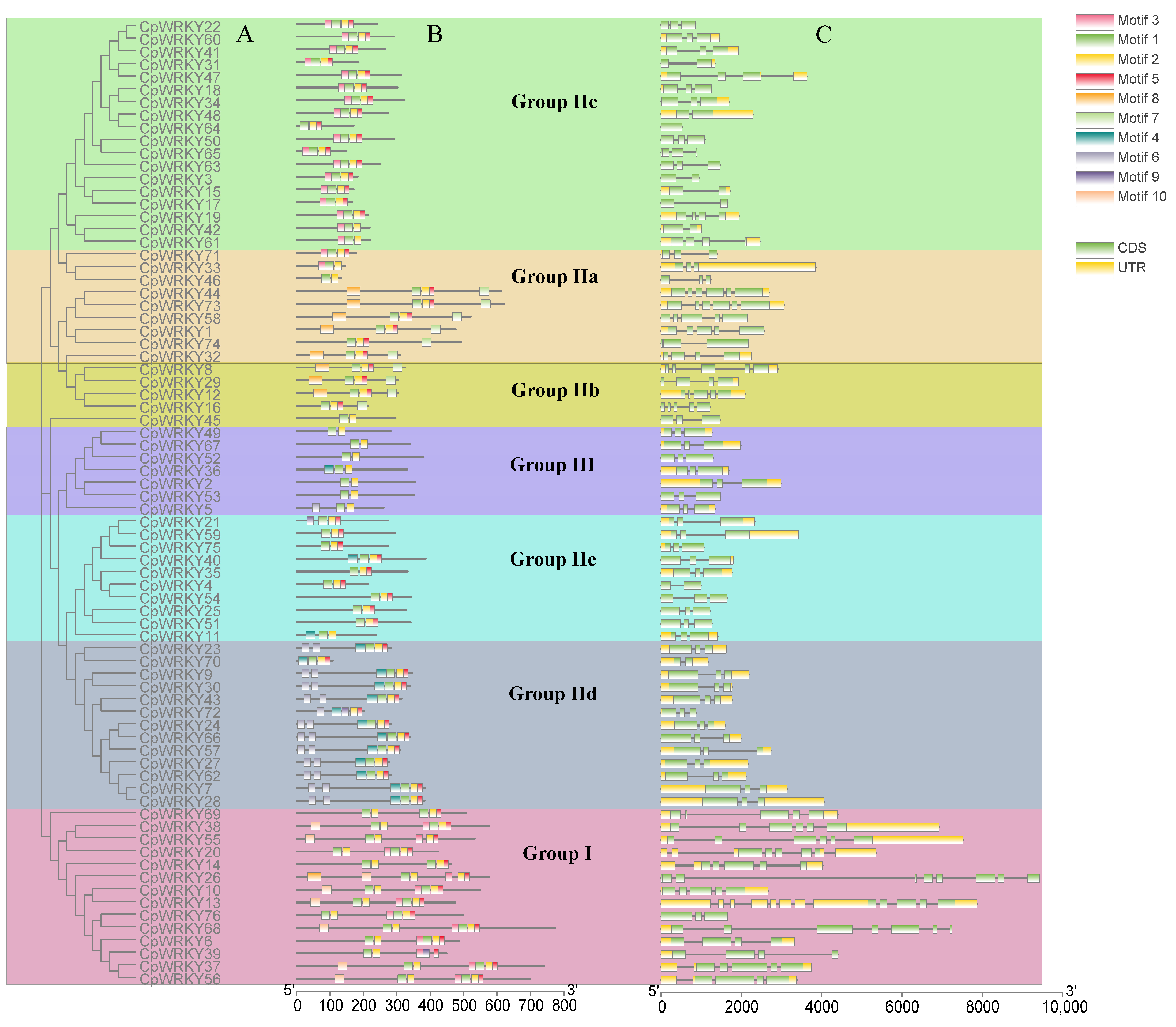
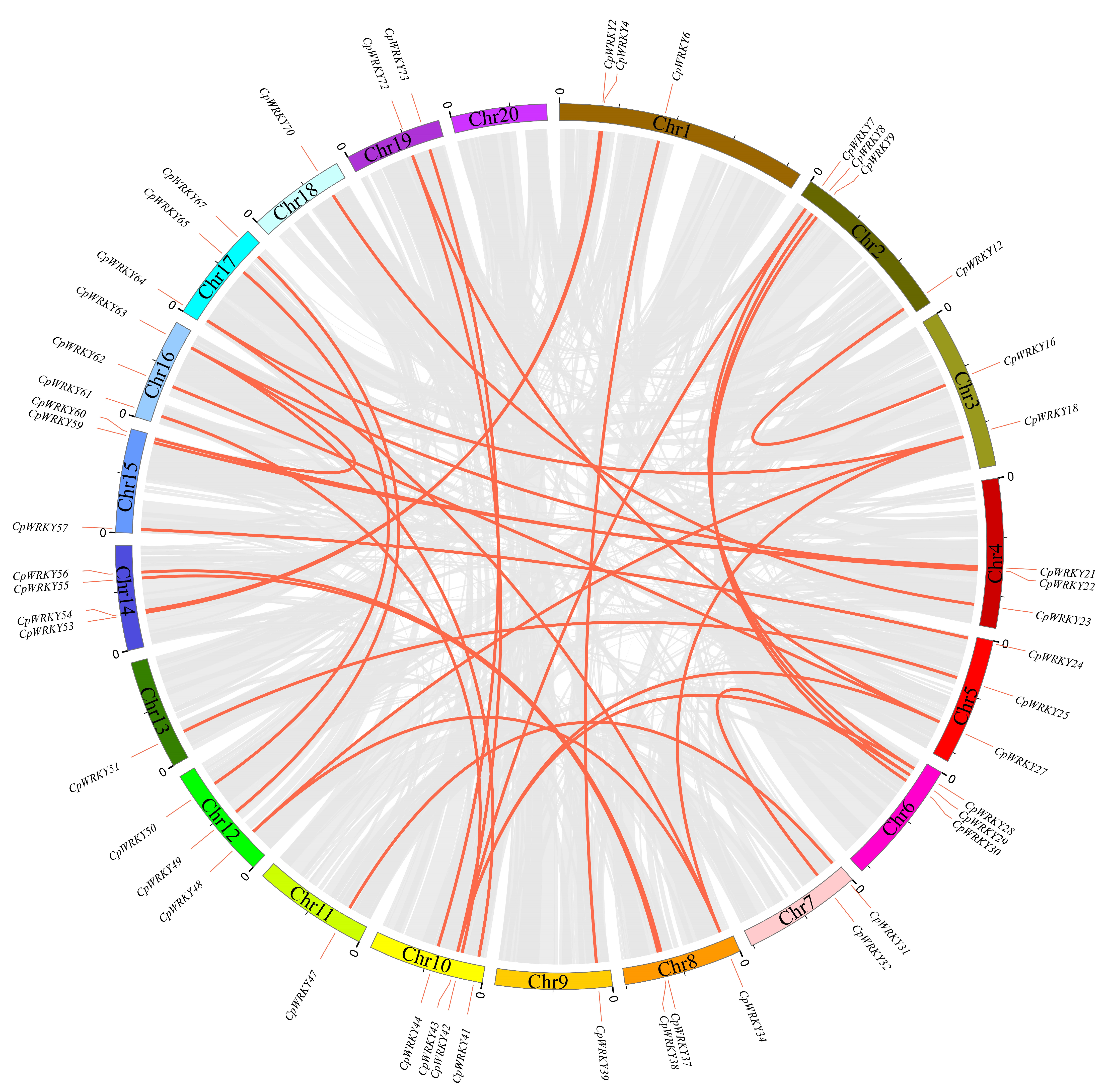


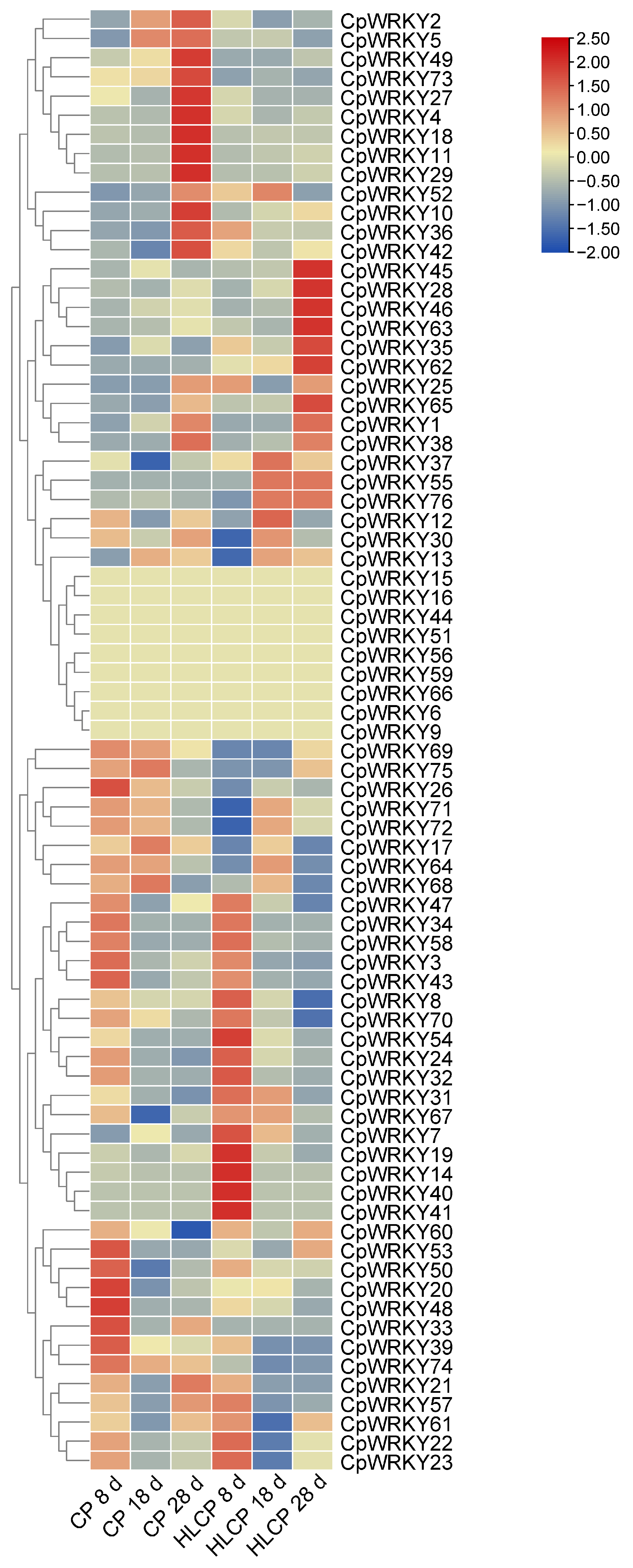

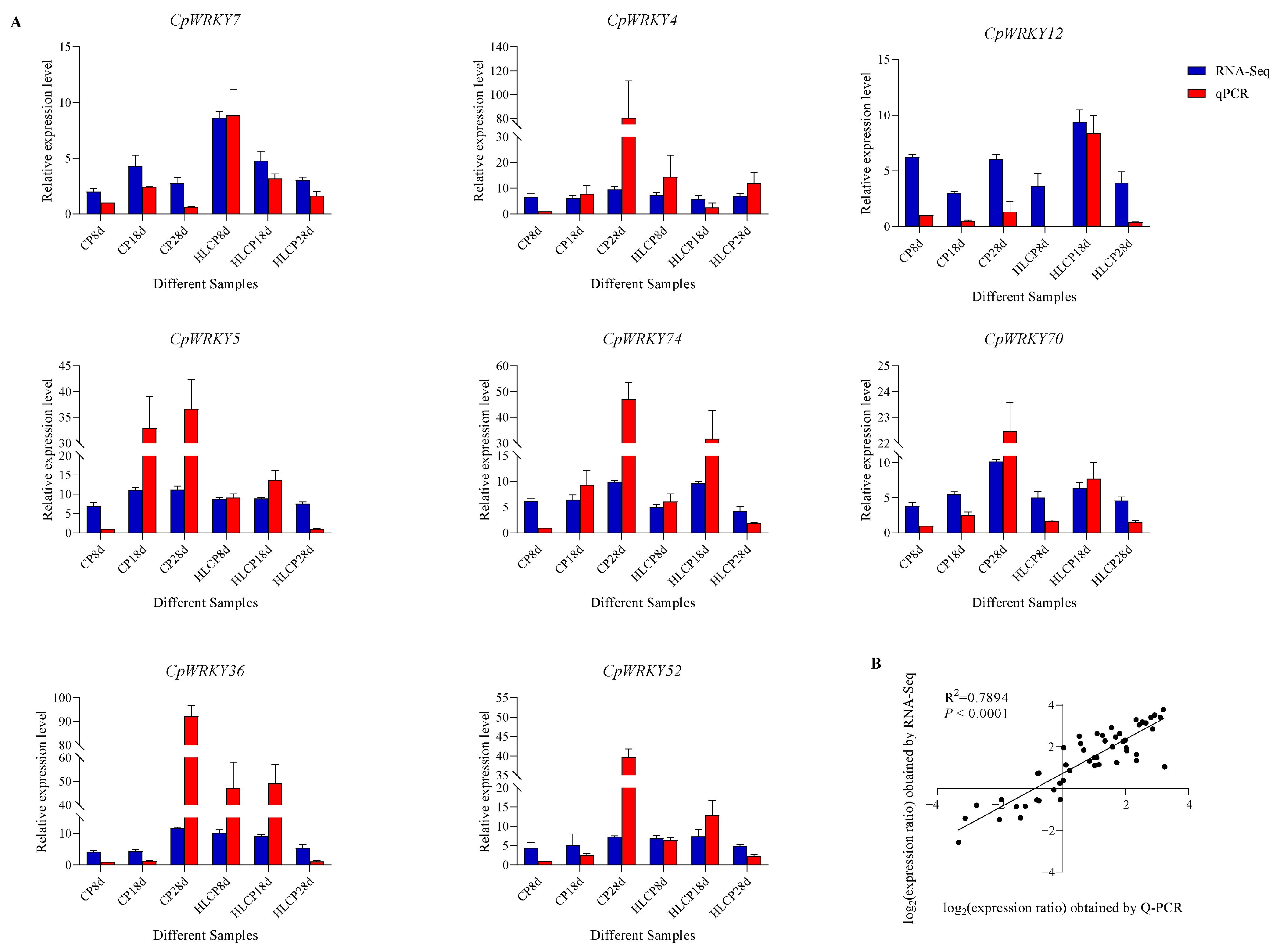

Disclaimer/Publisher’s Note: The statements, opinions and data contained in all publications are solely those of the individual author(s) and contributor(s) and not of MDPI and/or the editor(s). MDPI and/or the editor(s) disclaim responsibility for any injury to people or property resulting from any ideas, methods, instructions or products referred to in the content. |
© 2024 by the authors. Licensee MDPI, Basel, Switzerland. This article is an open access article distributed under the terms and conditions of the Creative Commons Attribution (CC BY) license (https://creativecommons.org/licenses/by/4.0/).
Share and Cite
Chen, J.; Tao, F.; Xue, Y.; Xu, B.; Li, X. Genome-Wide Identification of the WRKY Gene Family and Functional Characterization of CpWRKY5 in Cucurbita pepo. Int. J. Mol. Sci. 2024, 25, 4177. https://doi.org/10.3390/ijms25084177
Chen J, Tao F, Xue Y, Xu B, Li X. Genome-Wide Identification of the WRKY Gene Family and Functional Characterization of CpWRKY5 in Cucurbita pepo. International Journal of Molecular Sciences. 2024; 25(8):4177. https://doi.org/10.3390/ijms25084177
Chicago/Turabian StyleChen, Junhong, Fei Tao, Yingyu Xue, Bingliang Xu, and Xiaowei Li. 2024. "Genome-Wide Identification of the WRKY Gene Family and Functional Characterization of CpWRKY5 in Cucurbita pepo" International Journal of Molecular Sciences 25, no. 8: 4177. https://doi.org/10.3390/ijms25084177
APA StyleChen, J., Tao, F., Xue, Y., Xu, B., & Li, X. (2024). Genome-Wide Identification of the WRKY Gene Family and Functional Characterization of CpWRKY5 in Cucurbita pepo. International Journal of Molecular Sciences, 25(8), 4177. https://doi.org/10.3390/ijms25084177




